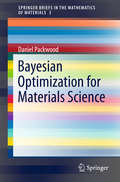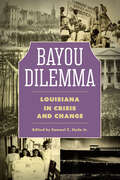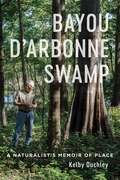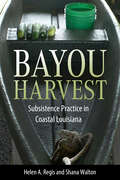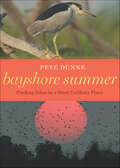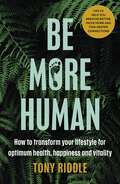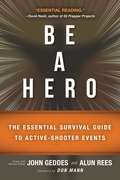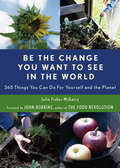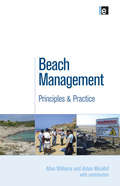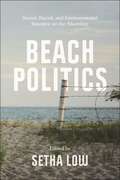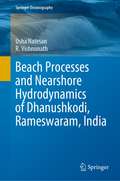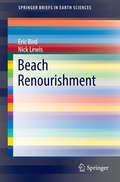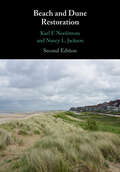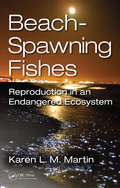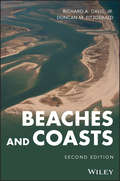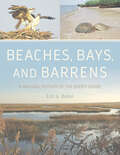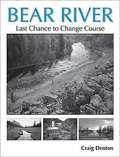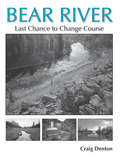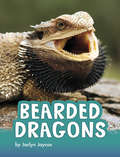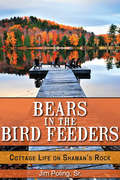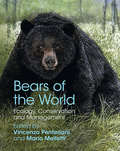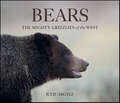- Table View
- List View
Bayesian Optimization for Materials Science (SpringerBriefs in the Mathematics of Materials #3)
by Daniel PackwoodThis book provides a short and concise introduction to Bayesian optimization specifically for experimental and computational materials scientists. After explaining the basic idea behind Bayesian optimization and some applications to materials science in Chapter 1, the mathematical theory of Bayesian optimization is outlined in Chapter 2. Finally, Chapter 3 discusses an application of Bayesian optimization to a complicated structure optimization problem in computational surface science. Bayesian optimization is a promising global optimization technique that originates in the field of machine learning and is starting to gain attention in materials science. For the purpose of materials design, Bayesian optimization can be used to predict new materials with novel properties without extensive screening of candidate materials. For the purpose of computational materials science, Bayesian optimization can be incorporated into first-principles calculations to perform efficient, global structure optimizations. While research in these directions has been reported in high-profile journals, until now there has been no textbook aimed specifically at materials scientists who wish to incorporate Bayesian optimization into their own research. This book will be accessible to researchers and students in materials science who have a basic background in calculus and linear algebra.
Bayesian Spatial Modelling with Conjugate Prior Models
by Henning Omre Torstein M. Fjeldstad Ole Bernhard ForbergThis book offers a comprehensive overview of statistical methodology for modelling and evaluating spatial variables useful in a variety of applications. These spatial variables fall into three categories: continuous, like terrain elevation; events, like tree locations; and mosaics, like medical images. Definitions and discussions of random field models are included for each of these three previously mentioned spatial variable types. Moreover, the readers will have access to algorithms suitable for applying this methodology in practical problem solving, and the computational efficiency of these algorithms are discussed. The presentation is made in a consistent predictive Bayesian framework, which allows separate modelling of the observation acquisition procedure, as a likelihood model, and of the spatial variable characteristics, as a prior spatial model. The likelihood and prior models uniquely define the posterior spatial model, which provides the basis for spatial simulations, spatial predictions with associated precisions, and model parameter inference. The emphasis is on Bayesian spatial modelling with conjugate pairs of likelihood and prior models that are analytically tractable and hence suitable for data abundant spatial studies. Alternative methods frequently used in spatial statistics are presented using a unified notation. The book is suitable as a textbook for a ‘Spatial Statistics’ course at the MSc or PhD level, as it also includes algorithm descriptions, project texts, and exercises.
Bayou Dilemma: Louisiana in Crisis and Change (America's Third Coast Series)
by Samuel C. HydeContributions by Janet Allured, Craig E. Colten, Marcus S. Cox, Pearson Cross, John Bel Edwards, Adam Fairclough, Keith M. Finley, Samuel C. Hyde Jr., John A. Lopez, and Robert Mann In the fall of 2022, a diverse group of scholars including scientists, historians, political scientists, geographers, and journalists, along with Governor John Bel Edwards, gathered to present views on the challenges that define life in Louisiana. Born out of the symposium, Bayou Dilemma: Louisiana in Crisis and Change is an unprecedented compilation that examines the social, political, environmental, and economic hurdles pervasive to the Gulf South and especially the Bayou State. The essays collected in the volume illuminate pressing problems confronting Louisiana and its surrounding environs, as well as some of the least known and most frequently misunderstood issues that have affected the state in the past. Topics include the problems of flood control, unequal treatment for African Americans and women, political corruption, endemic violence, and partisan applications of justice, as well as the crisis of coastal erosion, the dilemma of special interests shaping legislation, and the corresponding drain of talent from the state to regions offering improved opportunities. The anthology is a provocative and essential guide that reveals how such trials emerged, how they were overcome or managed, and how they continue to shape the Gulf South’s regional identity. Concentrating on the future well-being of the state and its occupants, the volume suggests fresh pathways for addressing these lingering concerns.
Bayou D’Arbonne Swamp: A Naturalist’s Memoir of Place
by Kelby OuchleyBayou D’Arbonne Swamp addresses the vibrant natural, cultural, and social history of a north Louisiana swamp. Kelby Ouchley grew up near Bayou D’Arbonne Swamp, and he later spent much of his professional life as a wildlife biologist and naturalist overseeing the national wildlife refuge created from much of the area. His deep personal and professional connections to the landscape give him valuable insight into the enormous changes that have struck the swamp over the last century and the reasons behind this transformation. In this fascinating narrative, Ouchley offers a kaleidoscopic view of Bayou D’Arbonne Swamp that reveals its unique past and distinctive flora, fauna, and people. Although these are stories of a particular swamp, they tell us much about issues facing other wetlands, as well as prairies, mountains, and deserts, when viewed through an ecological, social, and historical lens. Ouchley aims to foster an awareness of the environmental impacts of human decisions that encourages readers to consider ecological choices in their daily lives. The result is a work that presents an intimate and multilayered natural history of Bayou D’Arbonne Swamp that extends beyond the edges of the ever-changing Louisiana wetland, informing the environmental history of Louisiana, conservation, and ecological change.
Bayou Harvest: Subsistence Practice in Coastal Louisiana (America's Third Coast Series)
by Helen A. Regis Shana WaltonTo inhabitants of the Gulf Coast region of Louisiana, food is much more than nourishment. The acts of gathering, preparing, and sharing food are ways to raise children, bond with friends, and build community. In Bayou Harvest: Subsistence Practice in Coastal Louisiana, Helen A. Regis and Shana Walton examine how coastal residents deploy self-reliance and care for each other through harvesting and sharing food. Pulling from four years of fieldwork and study, Walton and Regis explore harvesting, hunting, and foraging by Native Americans, Cajuns, and other Bayou residents. This engagement with Indigenous thinkers and their neighbors yields a multifaceted view of subsistence in Louisiana. Readers will learn about coastal residents’ love for the land and water, their deep connections to place, and how they identify with their food and game heritage. The book also delves into their worries about the future, particularly storms, pollution, and land loss in the coastal region. Using a set of narratives that documents the everyday food practices of these communities, the authors conclude that subsistence is not so much a specific task like peeling shrimp or harvesting sassafras, but is fundamentally about what these activities mean to the people of the coast. Drawn together with immersive writing, this book explores a way of life that is vibrant, built on deep historical roots, and profoundly threatened by the Gulf’s shrinking coast.
Bayshore Summer: Finding Eden in a Most Unlikely Place
by Pete DunneBypassed by time and &“Joisey&” Shore–bound vacationers, the marshes and forests of the Bayshore constitute one of North America&’s last great undiscovered wild places. Sixty million people live within a tank of gas of this environmentally rich and diverse place, yet most miss out on the region&’s amazing spectacles. Bayshore Summer is a bridge that links the rest of the world to this timeless land. Pete Dunne acts as ambassador and tour guide, following Bayshore residents as they haul crab traps, bale salt hay, stake out deer poachers, and pick tomatoes. He examines and appreciates this fertile land, how we live off it and how all of us connect with it. From the shorebirds that converge by the thousands to gorge themselves on crab eggs to the delicious fresh produce that earned the Garden State its nickname, from the line-dropping expectancy of party boat fishing to the waterman who lives on a first-name basis with the birds around his boat, Bayshore Summer is at once an expansive and intimate portrait of a special place, a secret Eden, and a glimpse into a world as rich as summer and enduring as a whispered promise.
Be More Human: How to transform your lifestyle for optimum health, happiness and vitality
by Tony Riddle'Tony Riddle's mission is to present ways of living that are more in sync with our human biology, to help us thrive in this modern world' Dr Rangan Chatterjee'This book is brilliant with such an important message' The Happy Pear ___________________________The ultimate guide to boosting your mental and physical health by reconnecting with the way we, as humans, were supposed to live, eat, sleep, breathe and move.The bright lights, late nights and constant hustle of our modern world have detached us from the way we, as humans, were supposed to live, connect and thrive. Be More Human explores the importance of reconnecting with our natural state and help us learn how to meet our true needs and live more naturally. Tony Riddle (@thenaturallifestylist) will explore how the majority of us do not sit, breathe, eat, sleep or move as nature intended and so we're actively going against our biology. This book will help us all to reassess our habits and tap back into our natural rhythms and ways of being to optimise our mental and physical wellbeing, reduce stress, sit correctly, breathe better and improve our quality of sleep.Tony is committed to helping us reconnect with how we were built to live in a way that can be incorporated into our hectic, modern lifestyles. His expertise will make this a transformative, empowering and practical guide to getting back in tune with a happier, healthier self to discover physical, emotional, mental and spiritual strength and wellbeing.We can't all live in nature, but we can all live more naturally and learn how to thrive instead of just survive.___________________________'Inspiring read' Rich Roll, author of Finding Ultra'Vital stuff' Bruce Parry
Be a Hero: The Essential Survival Guide to Active-Shooter Events
by Don Mann John Geddes Alun ReesDealing with the unthinkableIt’s never going to be you. Then one day you hear the clatter of automatic fire at the mall. You have been drawn into the chaos and terror of an active shooter event. What do you do? Who do you turn to? Be a Hero is the essential guide to terrorist attacks that will help you survive. Former Special Air Service terror expert John Geddes will explain how to cope with a life-threatening event. He shows you how to make clear decisions and beat the odds by:Dealing with fear through simple and effective techniques to bring the chemical urges generated by terror at least partially under controlEscaping and evading when possible, using everyday objects and landmarks for protectionFighting back if needed, with methods to disarm an active shooter and to use items at hand as weaponsUsing a weapon if you are licensed to carry, shooting to kill without collateral damage or being mistaken for a perpetratorProviding medical assistance to deal with traumatic battlefield injury and save livesThis is not a book primarily for survivalists and 'preppers.’ Be a Hero is a book for ordinary men and women who could find themselves in the middle of an extraordinary moment. It will help them find the hero inside-and live to tell the tale.
Be the Change You Want to See in the World: 365 Things You Can Do For Yourself and the Planet
by John Robbins Julie Fisher-McgarryIn Be the Change You Want to See in the World, Julie Fisher-McGarry speaks to the burgeoning eco-conscious-consumer market on how to dwell well on a daily basis. Organized by month, she includes tips on living green, where to purchase organic and fair-trade products, how to unplug from the grid, supporting local economies, and nourishing the earth and creating a sustainable lifestyle.
Beach Management: Principles and Practice
by Allan Williams Anton MicallefThis comprehensive book provides full coverage of beach management principles and practice, with an emphasis on needs-based management. The book provides a wealth of case studies from the UK, USA, New Zealand, the Mediterranean, and Latin America. The emphasis throughout the book is on optimizing economic, social and environmental outcomes and reconciling competing needs in management planning for beach area. This book is an indispensable tool kit for all professionals in beach and coastal/beach zone management . It is also a comprehensive primer for university undergraduate students in professional planning, land management, coastal geography as well as tourism and conservation planning and management.
Beach Politics: Social, Racial, and Environmental Injustice on the Shoreline
by Setha LowExplores how elites restrict access to public beaches around the globeBeaches are a beloved form of public space. Yet there has been an alarming global trend of restricting access to public sections of beaches to ensure that waterfront property owners can enjoy the shoreline exclusively or develop the land for commercial use.Beach Politics examines how over the past forty years, privatization of public space has accelerated with the help of both local governments and national corporations. On a local level, this can entail a group of wealthy neighbors purposely blocking off public beach access in their neighborhood: hiring security guards, building fences, or putting up “No Trespassing” signs to turn away members of the public who have every right to be there. On a state or national level, it can manifest as gated communities owned by private corporations sectioning off huge swaths of land, limiting access, or governments promoting private, rather than public, development along the shoreline. Whenever disputes about land use arise, the powers that be often side with private interests and the wealthy over those with fewer resources and, frequently, people of color. With the continuing threat of climate change, decisions about how and where to harden or protect the shoreline often limits public use.Focused on beaches, access to public space, and social justice, this book brings together powerful contributions illustrating how these issues are inextricably bound with socioeconomic status, racial segregation, and climate justice. Together they highlight how, through illegal actions and exclusionary legislation, the beach can be transformed from “a strip of nature” into a palimpsest of greed, racism, ecological disregard, and socioeconomic discrimination.
Beach Processes and Nearshore Hydrodynamics of Dhanushkodi, Rameswaram, India (Springer Oceanography)
by Usha Natesan R. VishnunathThis book focuses on understanding the shoreline dynamics, nearshore processes and sediment transport around Rameswaram Island and the cities of Dhanushkodi and Arichamunai. Rameswaram Island is located between the Gulf of Mannar on the south and Palk Bay on the north, between the southern tip of India and Sri Lanka, and is unique in terms of physical, chemical and biological processes. The Gulf of Mannar is established as a marine biodiversity conservation area by its richness of variety and variability of marine species such as corals, finfish, shellfish and other fishes. The island is predominantly influenced by four seasons: northeast monsoon, post-monsoon, summer and southwest monsoon; and the sedimentological and hydrodynamic conditions significantly change seasonally, resulting in the island’s responding in a different manner with each season. It also explains the physical forces and their impacts around these areas. Rameswaram Island has existed naturally for a long period of time even under the influence of different water masses of the Gulf of Mannar and Palk Bay. Understanding the regional natural phenomena is the only solution to carry out the best management practices to develop coastal constructions and modifications.
Beach Renourishment (SpringerBriefs in Earth Sciences)
by Eric Bird Nick LewisBeach renourishment is the restoration of beaches that have been depleted. The text deals with the sources of beach sediment as well as the causes and typical responses to beach erosion, before discussion of beach renourishment. Some of the first documented renourishment projects were undertaken in the early 1900's on the east coast of the United States. Several countries have since renourished beaches, particularly during the past few decades. Most projects have been in the United States, the United Kingdom, some European countries and Australia. These are reviewed and experience from various beach renourishment projects used for discussion of the following topics: 1. The need for preliminary investigations 2. Sources of sediment for beach renourishment 3. Methods of beach renourishment 4. Design considerations 5. Monitoring changes after beach renourishment 6. Assessment of performance 7. Modelling of beach renourishment 8. Beach renourishment for coast protection 9. Environmental impacts 10. Costs and benefits 11. Response of renourished beaches to a rising sea level
Beach and Dune Restoration
by Karl F. NordstromThis new edition - now with Nancy Jackson as a co-author - continues the themes of the first edition: the need to restore the biodiversity, ecosystem health, and ecosystem services provided by coastal landforms and habitats, especially in the light of climate change. The second edition reports on progress made on practices identified in the first edition, presents additional case studies, and addresses new and emerging issues. It analyzes the tradeoffs involved in restoring beaches and dunes - especially on developed coasts - the most effective approaches to use, and how stakeholders can play an active role. The concept of restoration is broad, and includes physical, ecological, economic, social, and ethical principles and ideals. The book will be valuable for coastal scientists, engineers, planners, and managers, as well as shorefront residents. It will also serve as a useful supplementary reference textbook in courses dealing with issues of coastal management and ecology.
Beach-Spawning Fishes: Reproduction in an Endangered Ecosystem
by Karen L.M. MartinBeach-spawning fishes from exotic locations on most continents of the world provide spectacular examples of extreme adaptations during the most vulnerable life cycle stages. The beauty, intriguing biology, and importance of these charismatic fishes at the interface of marine and terrestrial ecosystems have inspired numerous scientific studies. Adap
Beaches and Coasts
by Richard A. Davis Jr. Duncan M. FitzgeraldA new edition of a unique textbook that provides an exhaustive treatment of the world's different coasts—with focus on climate change sea-level rise Coastlines of the world are as diverse and complex as any geological setting on Earth, and understanding them is extremely important. Beaches and Coasts, Second Edition is an exciting and unique textbook that covers the world’s different coasts and details the highly varied processes that have shaped them. This new edition emphasizes the future susceptibility of coast to climate driven stresses and decreasing sediment supplies, and considers various aspects of coastal management that are and/or that need to be undertaken. Seeking to better educate students and readers about the sustainability of coast and coastal environments, this exciting and unique book offers enlightening coverage of: the Earth’s mobile crust; sediments of coastal environments; impacts of sea level change; weather systems and the effects of storms; the influence of wave energy and different tidal regimes; river deltas; coastal bays; estuaries and lagoons; tidal flats; coastal wetlands; beach and nearshore areas; coastal barriers; tidal inlets; glaciated coasts; and rocky coasts. Takes an extensive look at the world's varied coasts and covers the many processes that have shaped them over time Shows how coastal processes and landform evolution are expected to be impacted by climate change Includes new coverage of Hurricane Katrina and the 2005 flooding of New Orleans, Hurricane Sandy and its affect on New York and the earthquake and tsunami in the Indian Ocean and Tohoku Lavishly illustrated with over 400 color photographs and figures Draws on a wealth of author experience that broadens the content of chapters and provides for numerous and varied examples Beaches and Coasts, Second Edition is an excellent text for undergraduate and graduate students of coastal geology, coastal processes and coastal environments.
Beaches, Bays, and Barrens: A Natural History of the Jersey Shore
by Eric G. BolenThe Jersey Shore attracts millions of visitors each year, drawn to its sandy beaches. Yet New Jersey’s coastline contains a richer array of biodiverse habitats than most tourists realize, from seagrass meadows to salt marshes to cranberry bogs. Beaches, Bays, and Barrens introduces readers to the natural wonders of the Jersey Shore, revealing its unique ecology and fascinating history. The journey begins with the contributions and discoveries of early naturalists who visited the region and an overview of endangered species and natural history, followed by chapters that explore different facets of the shore’s environments. These start with sandy beaches and dunes and culminate in the engaging Pine Barrens, the vital watershed for much of the state’s varied coastline. Along the way, readers will also learn about whaling, decoy carvers, an extinct duck, and the cultivation of wild blueberries. Including over seventy color photographs, the book also features twenty-three infoboxes that go deep into areas of ecological or historical interest, such as the Forsythe National Wildlife Refuge or the Jaws-like shark attacks of 1916. From Cape May to Sandy Hook, biologist Eric G. Bolen takes you on a guided tour of the Jersey Shore’s rich ecological heritage.
Beam Diagnostics in Superconducting Accelerating Cavities: The Extraction of Transverse Beam Position from Beam-Excited Higher Order Modes (Springer Theses)
by Pei ZhangAn energetic charged particle beam introduced to an rf cavity excites a wakefield therein. This wakefield can be decomposed into a series of higher order modes and multipoles, which for sufficiently small beam offsets are dominated by the dipole component. This work focuses on using these dipole modes to detect the beam position in third harmonic superconducting S-band cavities for light source applications. A rigorous examination of several means of analysing the beam position based on signals radiated to higher order modes ports is presented. Experimental results indicate a position resolution, based on this technique, of 20 microns over a complete module of 4 cavities. Methods are also indicated for improving the resolution and for applying this method to other cavity configurations. This work is distinguished by its clarity and potential for application to several other international facilities. The material is presented in a didactic style and is recommended both for students new to the field, and for scientists well-versed in the field of rf diagnostics.
Bear River: Last Chance to Change Course
by Craig DentonCraig Denton notes, “Water will be the primary political, social, and economic issue in the Intermountain West in the twenty-first century. ” Urban Utah thirsts for the Great Salt Lake principal source, the Bear River. Plans abound to divert it for a rapidly growing Wasatch Front, as the last good option for future water. But is it? Who now uses the river and how? Who are its stakeholders? What does the Bear mean to them? What is left for further use? How do we measure the Bear's own interest, give it a voice in decisions? Craig Denton's documentary takes on these questions. He tells the story of the river and the people, of many sorts, with diverse purposes, who live and depend on it. Bear River begins in alpine snowfields, lakes, and creeks in the Uinta Mountains, flows north through Wyoming, loops south in Idaho, and enters the inland sea by way of the an environmentally critical bird refuge. Along the way it has many uses: habitat, farms, electricity, recreation, lawns and homes. Denton researches the natural and human history of the river, photographed it, interviewed many stakeholders, and tried to capture the river perspective. His photographs, printed as crisp duotones, carry us downstream, ultimately to big questions, begging to be answered soon, about what we should and can make of the Bear River. Denton writes, Gravity my engine, Water my soul. I am the teller of life and deep time. You would measure me. Sever me. Own me. In your name. Let me flow In your imagination That I may speak.
Bear River: Last Chance to Change Course
by Craig DentonCraig Denton notes, “Water will be the primary political, social, and economic issue in the Intermountain West in the twenty-first century.” Urban Utah thirsts for the Great Salt Lake principal source, the Bear River. Plans abound to divert it for a rapidly growing Wasatch Front, as the last good option for future water. But is it? Who now uses the river and how? Who are its stakeholders? What does the Bear mean to them? What is left for further use? How do we measure the Bear's own interest, give it a voice in decisions? Craig Denton's documentary takes on these questions. He tells the story of the river and the people, of many sorts, with diverse purposes, who live and depend on it. Bear River begins in alpine snowfields, lakes, and creeks in the Uinta Mountains, flows north through Wyoming, loops south in Idaho, and enters the inland sea by way of the an environmentally critical bird refuge. Along the way it has many uses: habitat, farms, electricity, recreation, lawns and homes. Denton researches the natural and human history of the river, photographed it, interviewed many stakeholders, and tried to capture the river perspective. His photographs, printed as crisp duotones, carry us downstream, ultimately to big questions, begging to be answered soon, about what we should and can make of the Bear River. Denton writes, Gravity my engine, Water my soul. I am the teller of life and deep time. You would measure me. Sever me. Own me. In your name. Let me flow In your imagination That I may speak.
Bearded Dragons (Animals)
by Jaclyn JaycoxBearded dragons may not breathe fire or fly, but they are still impressive animals! These large lizards are found in Australia. They use venom to kill prey. Learn more details about these fascinating reptiles.
Bears in the Bird Feeders: Cottage Life on Shaman’s Rock
by Jim Poling Sr.As well as fun and relaxation, cottage living throughout the seasons is a reminder that all of us, even the most urbanized individual, are part of the natural world. Listen carefully and you will hear cottage country whispering lessons that can make our lives less frenetic, less complicated. The mournful call of the loon, the wind sighing in the trees, the hammering of the pileated woodpecker remind us that we are a part of a more natural world too often lost in our urban societies. Reflections from a still lake and a flickering campfire help us to realize that things might go easier for humankind if more issues were examined in softer, reflective light and without heated debate. People gathered at campfires, soothed by nature’s tranquility, tend to listen and be more thoughtful before they speak. This book will bring you on a journey through four seasons of cottaging and show you that nature has a remarkable power to heal – it just needs the human race to give it a helping hand. Along the way it will introduce you to some tips and tricks for making cottage life more comfortable and enjoyable.
Bears of the North: A Year Inside Their Worlds
by Wayne LynchAn unprecedented visual and scientific journey into the secret world of bears.In Bears of the North, renowned wildlife photographer, naturalist, and bestselling author Wayne Lynch offers us a work of scintillating science and stunning beauty. Following polar bears, brown bears, and American and Asiatic black bears through the seasons, this journey is an insider's view of hibernation's mysteries and the birth of cubs in winter; the mating rituals and voracious appetites of spring; hunting, fishing, and encounters with neighbors during summer; and the feeding frenzy and exuberant play of autumn. Dispelling the stereotypes and untruths—but none of the magic—surrounding these magnificent animals, Lynch comments on the latest scientific discoveries related to the biology, behavior, and ecology of bears. He describes how satellite telemetry has revealed the purpose behind the meanderings of bears and the great distances they sometimes cover on land and in water. He also shows how DNA analysis can teach us about the relatedness of bears within a population, even revealing the identity of a particular cub's father. Taking us out into the wilds of the tundra and forests to share his firsthand observations of the marvelous bears of the Northern Hemisphere, Lynch describes their survival strategies and the threats they face from habitat fragmentation and global climate change. Lynch's fascinating narrative is enhanced by over 150 gorgeous, original color photographs that capture bears in their habitats, including appearances of the elusive moon bear, fierce polar bear battles, and rare images of mothers' intimate moments with their cubs. Informed by Lynch's nearly forty years of experience observing and photographing bears in the wild, and aided by sophisticated digital photo technologies, Bears of the North is an unrivaled collection of enthralling and informative portraits of bears in their natural environments.
Bears of the World: Ecology, Conservation and Management
by Mario Melletti Vincenzo PenterianiBears have fascinated people since ancient times. The relationship between bears and humans dates back thousands of years, during which time we have also competed with bears for shelter and food. In modern times, bears have come under pressure through encroachment on their habitats, climate change, and illegal trade in their body parts, including the Asian bear bile market. The IUCN lists six bears as Vulnerable or Endangered, and even the Least Concern species, such as the brown bear, are at risk of extirpation in certain countries. The poaching and international trade of these most threatened populations are prohibited, but still ongoing. Covering all bear species worldwide, this beautifully illustrated volume brings together the contributions of 200 international bear experts on the ecology, conservation status, and management of the Ursidae family. It reveals the fascinating long history of interactions between humans and bears and the threats affecting these charismatic species.
Bears: The Mighty Grizzlies of the West
by Julie ArgyleThe mighty North American brown bear, most often referred to as the grizzly, is an iconic symbol of power and strength. Mostly found in the Western United States and Canada, the still-endangered bruin has made strides into a tenuous sustainability. The strikingly beautiful photography, and the essay woven through the pages of Bears: The Mighty Grizzlies of the West, showcases this beautiful, smart, and incredible species. Julie Argyle explores their behavior, their family dynamics, and what it means to be a grizzly in the wilderness of the greater Yellowstone area. She includes stories about individual bears: Raspberry and Snow, The Beryl Sow, The Obsidian Sow, Snaggletooth, and 791 (a famous boar), and looks at the issues of increasing conflicts between humans and the grizzlies and what the future holds for them.
